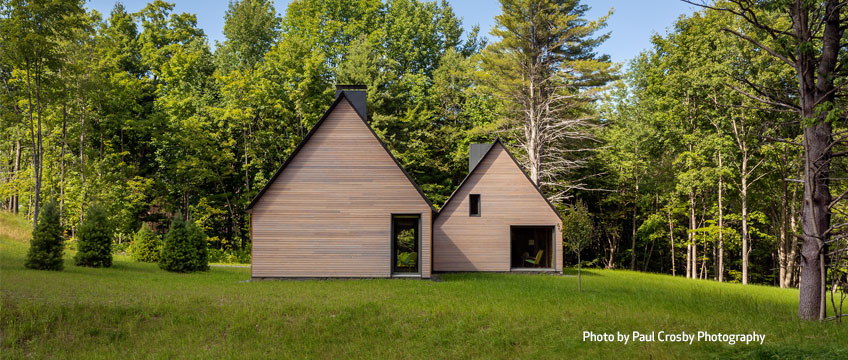HGA Architects and Engineers gives the Cape Cod form a modern slant with the Marlboro Music Cottages in rural Vermont
By Thomas Fisher, Assoc. AIA
Goethe called architecture “frozen music,” but the AIA Minnesota Honor Award–winning Marlboro Music Cottages also show how much music can “thaw” architecture. Designed by Joan Soranno, FAIA, with John Cook, FAIA, and Doug Gerlach, AIA, of HGA Architects and Engineers, the five houses have a warm, inviting quality in keeping with the classical music emanating from them. They’re home to the musicians and their families who attend the world-famous Marlboro Music Festival each summer in Vermont.
Standing along a former logging road near Marlboro College, the gable-roofed residences recall the region’s Cape Cod houses, which Soranno, who grew up in Boston, knows well. “The typical Cape,” she says, “has a 60/40 roof-to-wall relationship, a center chimney, and windows up against seven-foot-high eaves. We adhered to those intimate proportions while trying to reinterpret Capes in a fresh way.”
In this, they have succeeded—brilliantly. Like the musicians of Marlboro Music with their fresh interpretations of the classical repertoire, Soranno and Cook have made a 400-year-old form feel new and alive with possibility. They did so, in part, by recalling the spare quality of the first Capes, with their local materials and unpainted surfaces. The Marlboro cottages have naturally stained wood exteriors and unpainted interiors, with Vermont slate roofs and floors, local-stone foundation veneers, and native white-pine walls and ceilings. “The client wanted minimal maintenance,” says Cook, “so we used long-lasting materials and finishes.”
The design team minimized the details of the cottages as well. Although built of thick, structurally insulated panels, the energy-efficient residences have narrow roof edges, untrimmed window and door openings, and exposed timber rafters and joists, all of which recall the thin walls and unadorned features of early Capes. “We don’t come from the residential world,” says Cook—Soranno had never designed a residence before this project—“but our institutional experience taught us how to do a thin roof edge, for example.”
The architects’ background in institutional buildings also enabled them to question some of the traditional characteristics of Capes. Instead of the small openings in the typical Cape, they used floor-to-ceiling windows to connect the cottages to the surrounding woods and fields, and instead of low ceilings, they opened up the living spaces and master bedrooms with gabled ceilings to improve the acoustics for the musicians. “A strong connection exists between nature and music,” observes Soranno, and that comes through clearly in these cottages—so much so that Honor Awards juror Dan Rockhill said the pine-clad, timber-framed interiors reminded him of “being inside a wood instrument.”
The composition of the cottages’ forms and fenestration recalls aspects of musical composition as well. Their rectangular, gabled shapes, for example, “just kiss,” as Cook puts it, barely touching each other as they slide past one another, like variations on a theme moving across a musical score. The same theme and variation occurs on the cottages’ end walls, where large and small, square and rectangular windows play a lively visual game within the confines of the gable shape, and along the side walls, where the regular rhythm of windows sometimes aligns—and sometimes does not—with the same-sized openings on the opposite side.
“I always try to find ways to make a composition more dynamic,” says Soranno, “and yet I also am attracted to calm, primal forms.” Much of the enormous appeal of these cottages lies in the rich tension between those two sensibilities. “I like the way these cottages recall how most children draw a house, with a gable roof and center chimney,” she adds. But these structures also show how great architects, like the residents of these cottages, can collaborate in the making of beautiful music.
MARLBORO MUSIC: FIVE COTTAGES
Location: Marlboro, Vermont
Client: Marlboro Music
Architect: HGA Architects and Engineers
hga.com
Project team: Dan Avchen, FAIA; Rich Bonnin; John Cook, FAIA; Doug Gerlach, AIA; Ariane Laxo; Joan Soranno, FAIA
General contractor: Courtlan Construction
Size: 11,000 square feet
Cost: $3.42 million
Completion: August 2014
Photographer: Paul Crosby



